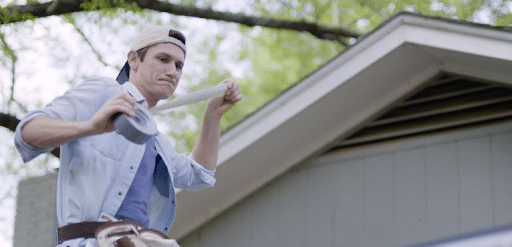(And Why You Absolutely Shouldn't)

So, you’ve got a Roof Leak. Maybe it’s a small drip, maybe it’s a full-fledged indoor waterfall situation, and you—being the resourceful DIY genius you are—reach for the most sacred tool in the household arsenal: duct tape.
We get it. It’s cheap. It’s easy. And hey, if it was good enough for NASA to fix a busted lunar rover fender on Apollo 17, surely it can handle a little roof leak, right?
Well, here’s the thing—NASA had actual rocket scientists handling their duct tape jobs. You? You’re up there in flip-flops, holding onto a gutter for dear life, hoping to patch your roof with the same tape you used to fix a broken TV remote. If that sounds like a bad idea, congratulations! You’re already smarter than the guy who actually tries this.
But just for fun, let’s break down exactly how you’d go about “fixing” your roof leak with duct tape—and why you should absolutely never do this unless you enjoy the fine art of home disaster management.
Step 1: Identify the Leak (Good Luck!)
Your instinct? Climb onto the roof with a roll of duct tape clenched between your teeth like a DIY action hero, scanning for that elusive drip like you’re auditioning for an off-brand home improvement survival show. Will you find the actual source? Probably not. But hey, at least the neighbors will get a show.
There’s also a solid chance that while you’re up there, you’ll discover that the leak is nowhere near where the water is coming in. Because, fun fact: water is petty. It won’t just leak straight down. No, it will travel along beams, creep behind drywall, and show up in the most inconvenient places possible, just to keep things interesting.
Step 2: Apply Generous Amounts of Duct Tape (Because That Always Works)
- Do you smooth it down? Yes.
- Do you layer it excessively? Obviously.
- Will it hold through the next rainstorm? About as well as a wet paper towel holding back a fire hydrant.
Duct tape was designed for quick fixes, not hurricane-level roof reinforcement. At best, it buys you a few hours before Mother Nature peels it off like a bad Band-Aid. At worst, you’ve just turned your roof into a sticky, leaky mess that now requires even more professional intervention.
And let’s not forget the aesthetics. A duct-taped roof is basically the home maintenance equivalent of putting a SpongeBob Band-Aid on a gaping head wound—it might make you feel better, but everyone else knows you need a doctor.
Step 3: Hope for the Best (While Preparing for the Worst)
Once your temporary patch job is complete, you might feel a sense of accomplishment. But before you get too comfortable, consider this: there’s a reason Good Shepherd Roofing has won Best of Gwinnett for five years in a row.
Homeowners across the area trust us to handle leaks, storm damage, and roof replacements with long-term solutions—not just quick fixes. We believe in craftsmanship, quality materials, and making sure you don’t have to worry about your roof every time it rains.
Whether you need a Full Roof Replacement, Emergency Repairs, Insurance Claim Guidance, or new Gutters and Guards, we’re here to help. Our goal is to keep your home safe and dry, without the guesswork and without the hassle.
So, before you find yourself back on the roof, battling wind, rain, and an unraveling roll of duct tape, let’s talk about a real solution. Your home deserves it—and so do you.

